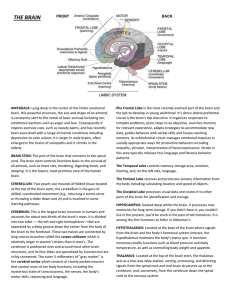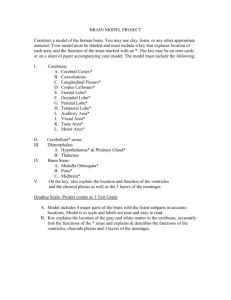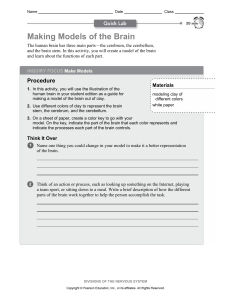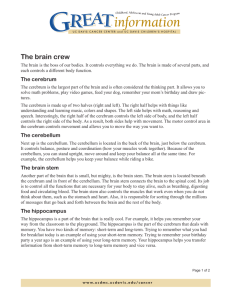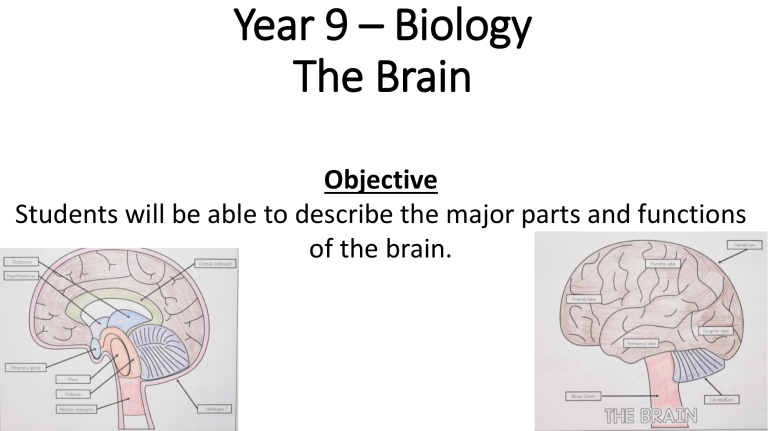
Year 9 – Biology The Brain Objective Students will be able to describe the major parts and functions of the brain. The Brain: There are 3 major regions of the brain: • The Cerebrum • The Cerebellum • The Brain Stem Cerebrum The cerebrum is the largest region of the brain. It is divided into a left and right hemisphere. Each side controls functions of the opposite side of the body. The cerebrum controls voluntary and conscious activities of the body. It also coordinates intelligence, learning and judgment. The two hemisphere are connected by the corpus callosum. The corpus callosum allows the left and right hemispheres to communicate with each other. Each hemisphere of the cerebrum is divided into 4 lobes: Frontal lobe: located at the front of brain, stores long-term memories, controls movements, help you make decisions and problem-solve Parietal lobe: located behind the frontal lobe, helps you interpret sensory information, pain, movement and orientation Temporal lobe: located below frontal lobes on the side of the brain, processes sensory information, language, new memories and emotions, helps you recognize faces/objects Occipital lobe: located in the back of the brain, receives and processes visual information from the eyes Cerebellum The cerebellum is located at the back of the brain. It controls coordination and balance of the body’s muscles. However, the command to move muscles comes from the cerebrum. Brain Stem The brain stem is located below the cerebrum. It connects the brain to the spinal cord. It regulates the flow of information between the rest of the brain and the body. The brain stem is separated into three regions: Pons: in front of the midbrain, relays signals from the front of the cerebrum to the cerebellum, controls sleep, respiration, swallowing and urination. Midbrain: helps relay information for vision and hearing and helps with motor control, alertness and temperature regulation. Medulla oblongata: directly connected to the spinal cord, controls autonomic functions such as heart rate, blood pressure and respiration rate and reflexes such as vomiting, coughing, sneezing and swallowing. Other Structures in the Brain Meninges: The brain is encased in membranes called meninges. Between the meninges and brain is fluid called cerebral spinal fluid (CSF). Together, the meninges and CSF cushion and protect the brain. Pituitary Gland: a small pea-sized structure in front and above the brain stem, the “master gland” of the endocrine system, secretes hormones that regulate growth, puberty and water balance and controls many endocrine glands. - Hypothalamus: connects the pituitary gland to the brain (thus, linking the nervous system to the endocrine system), controls the function of the pituitary gland and thus, the endocrine system, also helps control body temperature, hunger, thirst and the sleep-wake cycle. Thalamus: located behind the hypothalamus, major “relay center” because it receives sensory information and relays it to the proper area of the brain, also plays an important role in controlling consciousness and works with the hypothalamus to regulate the sleep-wake cycle. Cerebrum Parietal Lobe Frontal Lobe Occipital Lobe Temporal lobe Brain stem Cerebellum Thalamus Corpus callosum Hypothalamus Pituitary gland Pons Midbrain Medulla oblongata Meninges

